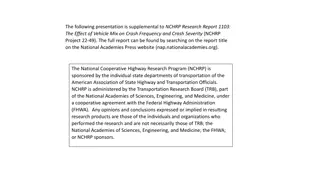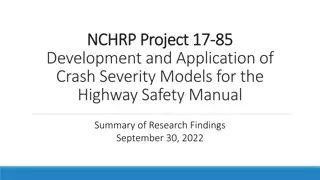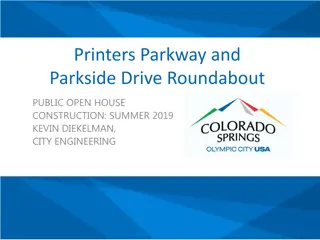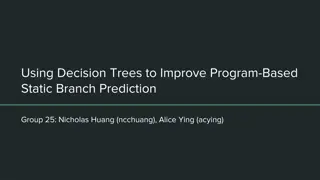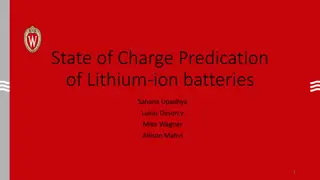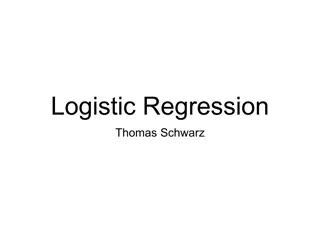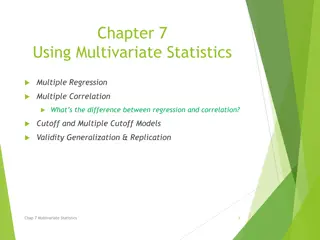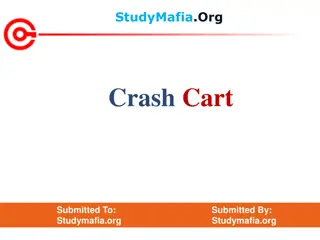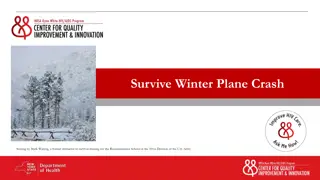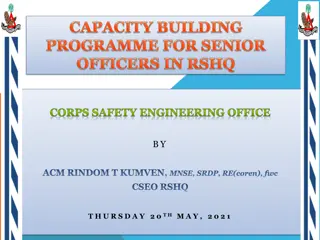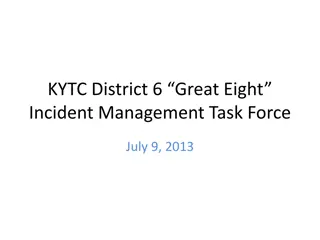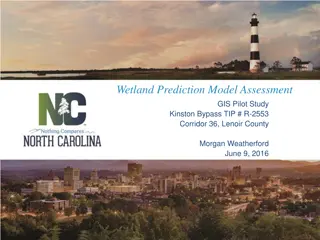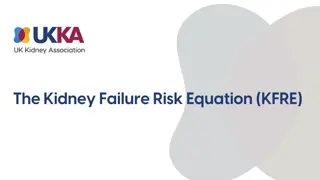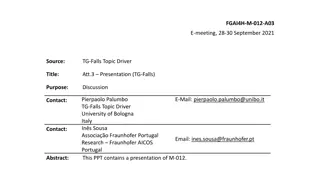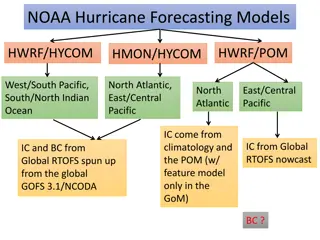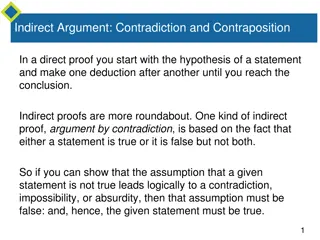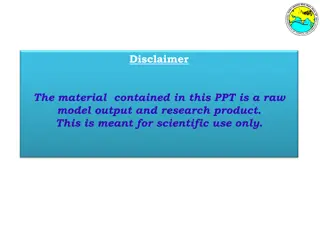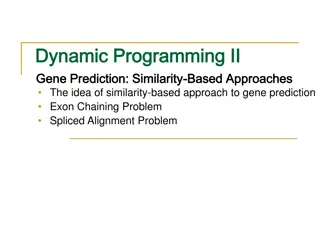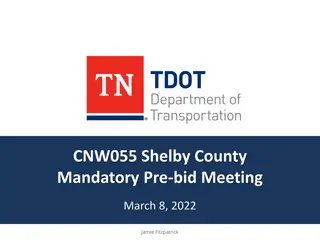Development of Roundabout Crash Prediction Models and Methods
This project focuses on developing Crash Prediction Models (CPMs) for U.S. roundabouts to enhance planning and design decisions. Geometric and operational features, as well as driver learning curves, are analyzed to understand their impact on crash severity. Data collected from various states forms the basis for model development, which involves a predictive approach using regression models. The CPMs are tailored for planning-level analysis, aiding in network screening and intersection control evaluations, with a focus on predicting crashes related to roundabout geometry or operation.
Download Presentation

Please find below an Image/Link to download the presentation.
The content on the website is provided AS IS for your information and personal use only. It may not be sold, licensed, or shared on other websites without obtaining consent from the author. Download presentation by click this link. If you encounter any issues during the download, it is possible that the publisher has removed the file from their server.
E N D
Presentation Transcript
NCHRP Project 17-70 Development of Roundabout Crash Prediction Models and Methods Kittelson & Associates, Inc. In association with: Persaud and Lyon, Inc. Write Rhetoric
Project Objectives Develop Crash Prediction Models (CPMs) for U.S. roundabouts for planning and design decisions Specific questions addressed: How do geometric features and combinations of features influence the number and severity of crashes at the roundabout? How do operational features and combinations of features influence the number and severity of crashes at the roundabout? How do driver learning curves influence the number and severity of crashes at any age roundabout? CPMs to be included in next edition of the HSM, SafetyAnalyst and IHSDM
Presentation Organization Data collected Model development approach CPMs developed Driver learning curve findings Conclusions
Data Collected Crash, traffic and geometric data collected CA, FL, KS, MI, MN, NC, NY, ON, PA, WA, WI Intersection-level CPMs 327 sites Leg-level CPMs 150 sites, 534 individual legs Driver learning curve 109 sites (FL, MI, NY, WA, WI)
Model Development Approach Consistent with HSM chapter C predictive chapters Crashes predicted with a combination of SPFs and CMFs Cross-sectional negative binomial regression models developed Annual crash frequency modeled as a function of traffic volumes and geometric variables
CPMs for Planning-Level Analysis Apply to entire intersection Developed using only AADT variables and basic geometric variables that would be known at the planning stage Models are applicable for average conditions of other geometric characteristics CPMs used early in the project development process Network screening Intersection control evaluations Predict crashes per year for crashes within circulating roadway and on legs and considered related to roundabout geometry or operation Pedestrian and bicycle crashes not included
CPMs for Planning-Level Analysis Rural Roundabouts N = expaMAJAADTbMINAADTcexpd NUMBERLEGS+e CIRCLANES N = predicted average crash frequency, crashes/yr MAJAADT = Total entering AADT on major road MINAADT = Total entering AADT on minor road NUMBERLEGS = 1 if a 3-leg roundabout; 0 if 4-legs CIRCLANES = 1 if a single lane roundabout; 0 if more than 1 circulating lanes
CPMs for Planning-Level Analysis Rural Roundabouts N = expaMAJAADTbMINAADTcexpd NUMBERLEGS+e CIRCLANES Severity a b c d e k TOT -5.3299 0.3356 0.5142 -0.6854 -0.9375 0.6292 FI - 10.4848 0.7756 0.4239 -1.0080 -0.5506 0.4424 PDO -5.4115 0.2980 0.5463 -0.7104 -1.0192 0.7284
CPMs for Planning-Level Analysis Urban Single-Lane Roundabouts N = expaMAJAADTbMINAADTcexpd NUMBERLEGS Severity a b c d k TOT -5.6049 0.3274 0.3960 -0.8681 0.5030 FI -8.6597 0.5271 0.3505 -0.7317 0.3290 PDO -5.5319 0.2653 0.4294 -0.9260 0.6064
CPMs for Planning-Level Analysis Urban Two-Lane Roundabouts N = expaMAJAADTbMINAADTcexpd NUMBERLEGS Severity a b c d k TOT -5.6642 0.5210 0.2905 -0.4610 0.9263 FI -10.3369 0.9134 0.1937 -0.5131 0.5611 PDO -5.7669 0.4954 0.3098 -0.4618 1.0642
CPMs for Intersection-Level Design Decisions CPMs used during design or retrofit work Predict crashes per year for crashes within circulating roadway and on legs and considered related to roundabout geometry or operation Pedestrian and bicycle crashes not included CPMs developed for four site types 3 legs 1 circulating lane 3 legs 2 circulating lanes 4 legs 1 circulating lane 4 legs 2 circulating lanes
CPMs for Intersection-Level Design Decisions Model form: N = NSPF CMF1... CMF2 NSPF= expa+c x Irural (ENTAADT/1000)b NSPF= predicted average crash frequency for base conditions on all legs, crashes/yr EntAADT = entering AADT for roundabout, veh/d Irural= area type indicator variable (= 1 if rural, 0 if urban) CMFs developed including various geometric variables SPFs developed for fatal+injury (FI) crashes and PDO crashes
CPMs for Intersection-Level Design Decisions N = expa+c x Irural(ENTAADT/1000)b Site/Severity Type a b c k FI 3 leg 1 circulating lane -4.404 1.084 0.206 0.31 3 leg 2 circulating lanes -3.887 1.306 0.250 0.36 4 leg 1 circulating lane -3.503 0.915 0.206 0.33 4 leg 2 circulating lanes -3.535 1.276 0.250 0.45 PDO 3 leg 1 circulating lane -1.720 0.486 1.055 0.168 0.496 0.54 1.06 3 leg 2 circulating lanes -1.565 4 leg 1 circulating lane -1.475 -1.536 0.702 1.131 0.168 0.496 0.80 0.79 4 leg 2 circulating lanes
CPMs for Intersection-Level Design Decisions Crash type distributions provided by site and severity type Head-on Right-angle Rear-end SSSD Other single-vehicle Animal Fixed-Object Other-Object Parked vehicle Other multiple-vehicle
CPMs for Intersection-Level Design Decisions Pedestrian and bicycle crashes too few to model so are not included In data, 1% were vehicle-bicycle and 0.4% vehicle-pedestrian
CPMs for Intersection-Level Design Decisions Optional application of Severity Distribution Functions Break down estimates of FI into individual K, A, B, C estimates Considers speed limits on approaches (between 10 to 60 mph) Factor is leg specific
CPMs for Intersection-Level Design Decisions STEP 1 fj,sl = exp[3.1187 x {(SLj/100)2 (35/100)2}] fj,sl = severity adjustment factor for leg j SLj = speed limit on leg j in mph
CPMs for Intersection-Level Design Decisions STEP 2 Sk = exp[Fk] x [p1 x f1,sl + p2 x f2,sl +p3 x f3,sl +p4 x f4,sl ] SA = exp[FA] x [p1 x f1,sl + p2 x f2,sl +p3 x f3,sl +p4 x f4,sl ] SB = exp[FB] x [p1 x f1,sl + p2 x f2,sl +p3 x f3,sl +p4 x f4,sl ] Pi = AADTi/(AADT1+AADT2+AADT3+AADT4) P1to4 = proportion of total roundabout volume on leg FK, FA and FB estimated for each combination of number of legs and circulating lanes
CPMs for Intersection-Level Design Decisions STEP 3 PK = SK/(1+SK+SA+SB) PA = SA/(1+SK+SA+SB) PB = SB/(1+SK+SA+SB) PC = 1-(PK+PA+PB)
CMFs for Intersection-Level Design Decisions Two Types of CMFs Developed Those that apply to entire roundabout Those that apply to specific legs Leg-level CMFs are combined into a entire roundabout CMF prior to applying to SPF CMFs do not necessarily apply to all combinations of number of legs, circulating lanes and crash severities Where CMFs are not provided the evidence was insufficient
CMFs for Intersection-Level Design Decisions CMFICD Inscribed Circle Diameter Applies to: urban roundabouts with a single circulating lane, ICD from 90 to 160 ft. Severity: FI CMFICD = exp(-0.00621 x (ICD 125)]
CMFs for Intersection-Level Design Decisions CMFoutbd Outbound-Only Leg Applies to: urban/suburban/rural that are a interchange ramp terminal with crossroad with only one outbound only leg Severity: FI 1 Circulating Lane 0.426 2 Circulating Lanes 0.455
CMFs for Intersection-Level Design Decisions CMFbypass Right-Turn Bypass Lane Applies to Individual leg in any area type Severity FI CMF 0.355
CMFs for Intersection-Level Design Decisions CMFap Access Point Frequency Applies to Individual leg in any area type Severity FI, PDO CMFap, FI = exp(0.0659 x nap] CMFap, PDO = exp(0.0885 x nap] nap,= number of driveways or unsignalized access points on leg within 250 ft of yield line
CMFs for Intersection-Level Design Decisions CMFew Entry Width Applies to Individual leg in any area type with 2 circulating lanes Severity FI, PDO CMFew, FI = exp(-0.0300 x 29] CMFew, PDO = exp(-0.0390 x 29]
CMFs for Intersection-Level Design Decisions CMFcl Circulating Lanes Applies to Individual leg in any area type (not outbound only legs) Severity FI, PDO CMFcl, FI = exp(0.1960 x (ncl x nel -4)] CMFcl, PDO = exp(0.2190 x (ncl x nel-4)] ncl = number of circulating lanes nel = number of entering lanes
CMFs for Intersection-Level Design Decisions Aggregating Leg-Level CMFs to apply to roundabout Step 1 CMFleg = CMFbypass x CMFap x CMFew x CMFcl Step 2 CMFRnbt =(p1 x CMF1)+(p2 x CMF2)+(p3 x CMF3)+(p4 x CMF4) Pi = AADTi/(AADT1+AADT2+AADT3+AADT4) P1to4 = proportion of total roundabout volume on leg CMF1to4 = Combined CMFleg for each leg
CPMs for Leg-Level Design Decisions CPMs used during design or retrofit process Predict crashes per year for crashes associated with a specific roundabout leg Pedestrian and bicycle crashes not included Crash Types Modeled Entering-circulating (all severities and FI) Exiting-circulating (all severities) Rear-end (all severities) Single-vehicle approach (all severities) Single-vehicle approach + circulating (all severities) Circulating-circulating (all severities) Total (all severities)
CPMs for Leg-Level Design Decisions Entering-Circulating Crashes N = expa(ENTAADT/1000)b(CIRCAADT)c Exiting-Circulating Crashes N = expa(EXTAADT/1000)b(CIRCAADT)c Rear-End Approach Crashes N = expa(APPRAADT/1000)b(CIRCAADT)c SV Approach and SV Approach +SV Circulating Crashes N = expa(APPRAADT/1000)b N = crashes per year related to leg ENTAADT entering AADT EXTAADT exiting AADT CIRCAADT circulating AADT APPRAADT approach AADT Circulating-Circulating Crashes N = expa(CIRCAADT/1000)b Total Crashes N = expa(APPRAADT/1000)b(CIRCAADT)c
CPMs for Leg-Level Design Decisions Entering-Circulating Crashes N = expa(ENTAADT/1000)b(CIRCAADT)c Severity Entering Lanes Circulating Lanes a Coefficient k b c 1 1 -2.584 0.6091 0.3020 0.7470 1 2 -0.314 0.9636 0.3917 0.6232 KABCO 2 1 -5.784 0.3608 0.6711 1.0734 2 2 -3.006 0.8054 0.7398 0.7759
CMFs for Leg-Level Design Decisions CMFs developed for: ICD inscribed circle diameter Angle angle to next leg Circwidth circulating width NumberAccess number of access points within 250ft. Luminaires Number of luminaires within 250 ft. PostedSpeed Posted speed limit on approach
CMFs for Leg-Level Design Decisions Entering-Circulating Crashes All Severities Variable Circulating Lanes Entering Lanes Variable Levels CMF/unit change Base minimum maximum Value Circulating Width 1 2 15 ft. 42 ft. 1.0324 2 1 30 ft. 25 ft. 45 ft. 0.9860 2 2 24 ft. 45 ft. 0.8715 ICD 1 1 65 ft. 236 ft. 0.9932 1 2 150 ft. 110 ft. 314 ft. 0.9918 2 1 135 ft. 426 ft. 0.9853 Angle 1 2 53 182 0.9769 90 2 2 69 182 0.9867 Bypass Lane 1 1 None 0.3685
CMFs for Leg-Level Design Decisions Entering-Circulating Crashes KABC Severities Variable Circulating Lanes Entering Lanes Variable Levels CMF/unit increase Base maximum minimum Value ICD 1 or 2 1 or 2 150 ft. 65 426 0.9951 Angle 1 or 2 1 or 2 90 37 186 0.9825
CMFs for Leg-Level Design Decisions Exiting-Circulating Crashes All Severities Variable Circulatin g Lanes Entering Lanes Variable Levels CMF/unit increase Base maximum minimum Value Circulating Width 1 2 30 ft 15 ft. 42 ft. 1.198 2 1 30 ft 25 ft. 45 ft. 0.772 ICD 2 1 150 ft 110 ft. 426 ft. 0.985
CMFs for Leg-Level Design Decisions Rear-End Crashes All Severities Variable Circulating Lanes Entering Lanes Variable Levels CMF/unit increase Base maximum minimum Value 1 or 2 1 or 2 1 0 8 1.094 NumberAccess 1 or 2 1 or 2 2 0 8 0.937 Luminaires
CMFs for Leg-Level Design Decisions Single-Vehicle Approach Crashes All Severities Variable Circulating Lanes Entering Lanes Variable Levels CMF/unit increase Base maximum minimum Value Posted Speed 1 or 2 1 or 2 40 mph 10 mph 60 mph 1.0451
CMFs for Leg-Level Design Decisions Circulating-Circulating Crashes All Severities Variable Circulatin g Lanes Entering Lanes Variable Levels CMF/unit increase Base maximum minimum Value Circulating Width 1 or 2 1 or 2 30 ft. 24 ft. 45 ft. 0.917
CMFs for Leg-Level Design Decisions Single-Vehicle Approach + Single-Vehicle Circulating Crashes All Severities Variable Circulating Lanes Entering Lanes Variable Levels CMF/unit increase Base maximum minimum Value 1 or 2 1 or 2 1 or 2 1 or 2 40 mph 30 ft. 10 mph 14 ft. 60 mph 45 ft. 1.0356 0.9771 PostedSpeed CircWidth
Effect of a Driver Learning Curve Testing thesis that driver behavior and safety may improve with familiarity Developed intersection-level SPFs including a variable for years post construction 109 sites where opening data was known were used Any trends are weak and vary from state to state Based on findings there is no satisfactory evidence of a driver learning curve Possible that DLC is for a shorter time period, e.g. over first few months of year 1, if one exists
Conclusions CPMs developed for both intersection-level and leg-level design analyses for U.S. roundabouts Estimate how geometric and operational features influence the number and severity of crashes SPFs also developed for planning-level analyses or network screening CPMs to be included in next edition of the HSM, SafetyAnalyst and IHSDM



